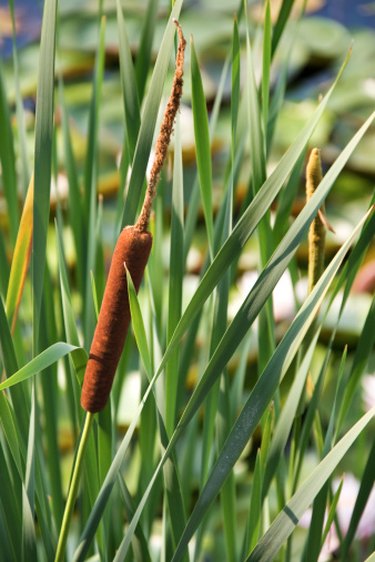Things You'll Need
Sharp knife or utility scissors
Cotton string
Old screen doors or screen attached to 2-by-4 frames
Rolls of corrugated cardboard sheeting, 3 to 4 feet wide
Duct tape
Plastic sheeting
Full size flat bed sheet
Spray bottle
Cardboard
Thumbtacks
Glue
Laminate or polyurethane (optional)

Cattails are possibly the most common wetland plant in North America, recognizable by their long, flat leaves and distinctive flowering stalk reaching 3 to 10 feet high. Two types of cattail grow in the U.S.: a broad-leaf cattail and a narrow-leaf cattail. Native Americans wove cattails into items such as mats, baskets, bags, shoes, military apparatus, and toys using both finger weaving and braiding. Today, weavers use cattails to make a variety of additional items such as hats, place mats and chair seats.
Step 1
Harvest cattail leaves in late summer or early autumn. Look for cattails in shallow water near the edges of ponds and lakes, in drainage ditches, and in marshes. Cut with a knife or scissors just above the waterline, leaving the root in place. Bundle the leaves with all of the butt ends together and tie with string for easier transport.
Video of the Day
Step 2
Prepare and dry the cattail leaves at home. Cut off the leaf tips and the thick ends while still bundled. Then separate and rinse the leaves with water. Split the cattails lengthwise down the middle with the knife if using broad-leaf cattails. Lay the leaves flat on the screen with 2-by-4 frame or old screen doors. Elevate the screen drying racks off the ground on sawhorses or on garage rafters so air can circulate around them. Turn the leaves several times a day to prevent mold or mildew. Drying time varies from several days to several weeks depending upon temperature, humidity and moisture content of leaves.
Step 3
Bundle and store the cattail leaves when dry. Select enough leaves to make a bundle about 10 inches in diameter and wrap snug with the corrugated cardboard, being careful not to bend or break the leaves. Secure the cardboard with duct tape. Store upright in a dry area away from sunlight.
Step 4
Prepare the cattail leaves for weaving. Lay the plastic sheeting on a large flat surface such as a floor, lawn or deck. Lay the bed sheet on top of the plastic. Remove a handful of dried leaves from the bundle. Spread the leaves out on the sheet with the butt ends together. Use the spray bottle to saturate the leaves. Roll up the leaves in the sheet and then wrap loosely in the plastic sheeting. Lay horizontally on the flat surface and let sit for eight to 12 hours. Test the leaves every three to four hours for readiness. The leaves are ready when they feel soft like chamois. Leave to mellow longer if the leaves crack and break when twisted. The leaves are too wet or have mellowed too long if slimy and soggy. Wash and dry the sheet before readying the next batch.
Step 5
Weave the leaves in weaving projects. Cattails can be used like any other weaving material in a variety of weaving projects. Make a woven cattail place mat by attaching one end of eight cattail leaves to cardboard with thumbtacks. Place the cattails snugly next to each other. Weave lengths of cattail over and under the attached cattails until the place mat reaches the desired length. Trim ends with utility scissors. Glue down ends all around. Laminate or seal with polyurethane if desired.
Tip
Tightly wrap or weave both fresh and prepared cattail leaves because they shrink a great deal as they dry.
Warning
Exposing drying cattails to direct sunlight causes them to turn brown quickly.
Be careful with dry cattail leaves as they bend and break easily.
Only ready enough cattail leaves to use in a day because the leaves mold swiftly.
Video of the Day